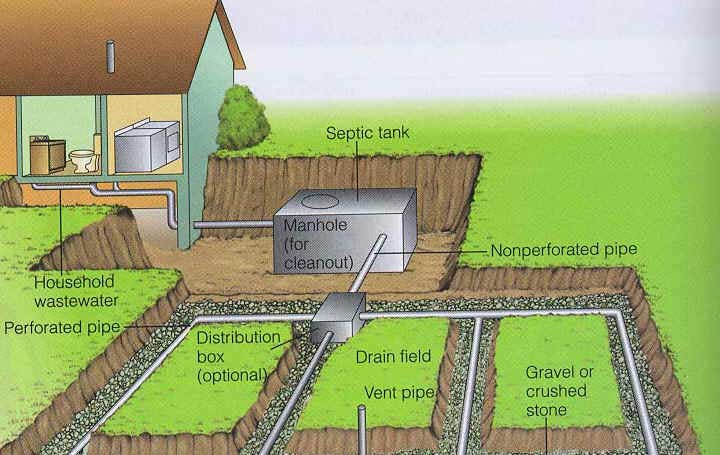When you flush,
where does it go? There are three ways
that we deal with sewage and other
wastewater from modern homes. For those
who live in one of Montana's larger cities, a
wastewater treatment plant (a.k.a. sewage
treatment plant) is used. In smaller
communities, wastewater most likely ends up
in a "lagoon" or series of lagoons. For homes
that are not connected to community systems,
septic systems are used to treat the material
that goes down drains and toilets. There are three ways
that we deal with sewage and other
wastewater from modern homes. For those
who live in one of Montana's larger cities, a
wastewater treatment plant (a.k.a. sewage
treatment plant) is used. In smaller
communities, wastewater most likely ends up
in a "lagoon" or series of lagoons. For homes
that are not connected to community systems,
septic systems are used to treat the material
that goes down drains and toilets.
The dirty work . . .
This photo shows the "septic tank" portion of a
septic system for a house that was being built near Montana City.
Eventually the tank was covered with dirt.
Once completed, gravity will pull wastewater
from the house (through a pipe) into the
concrete box where solids will settle to the
bottom. Helpful bacteria will beak down this
solid waste into a material referred to as "sludge".
Lighter solids such as hair and grease will
float to the top. Periodically both of these
layers will need to be removed by a septic
pumping business. NOTE: A baseball cap has been placed on the septic tank to give
you a sense of how big it is.
Lawns like it . . .
The liquid portion of the wastewater, called
"effluent" flows out of the tank through a pipe
that takes it to a drain field. The drain field
(a.k.a. leach field) consists of a series of
underground pipes that are surrounded by
gravel so that the effluent can easily trickle out through holes in the pipe(s)
and soak into the soil. The soil acts as a
natural filter, removing disease-causing
bacteria, nitrates, and phosphates. The effluent provides moisture and nutrients, so grass and other vegetation tend to grow well above the drain field.
Groundwater quality . . .
Modern septic systems are effective in most
situations with proper maintenance. As long as there are several feet of
the right kind of soil between the drain field
and the water table, groundwater
contamination should not be a problem.
However, in some situations where the water
table is high, nitrate contamination from
human waste may be a concern. Water
tables tend to be close to the surface near lakes
and streams, and near the lower parts of
valleys. Nitrates that seep into lakes or rivers
from septic systems can contribute to algae
blooms, leading to lower levels of dissolved
oxygen in the water. High levels of nitrates in
drinking water is very unhealthy for babies, and may lead to a disease called "blue baby syndrome". Furthermore, the presence of nitrates in well water is an indicator that effluent from the septic system is affecting the quality of the groundwater.
Inspection programs in the future? . . .
Recent testing of water from some wells in the Helena Valley Aquifer found all sorts contaminants, including trace amounts of medications and sunscreens. Medications enter the septic system through the urine of those taking the medication (anti-depressants, hormones, etc.), while sunscreen and other personal care products enter as showers drain into the septic tank. Concern about the quality of water in the Helena Valley Aquifer has prompted the county to initiate a program that requires septic system owners to have their systems tested on a regular basis.

Courtesy of Thurston County (Washington State) Public Health & Social Services Department
Term: blue baby syndrome
|


 There are three ways
that we deal with sewage and other
wastewater from modern homes. For those
who live in one of Montana's larger cities, a
wastewater treatment plant (a.k.a. sewage
treatment plant) is used. In smaller
communities, wastewater most likely ends up
in a "lagoon" or series of lagoons. For homes
that are not connected to community systems,
septic systems are used to treat the material
that goes down drains and toilets.
There are three ways
that we deal with sewage and other
wastewater from modern homes. For those
who live in one of Montana's larger cities, a
wastewater treatment plant (a.k.a. sewage
treatment plant) is used. In smaller
communities, wastewater most likely ends up
in a "lagoon" or series of lagoons. For homes
that are not connected to community systems,
septic systems are used to treat the material
that goes down drains and toilets.



